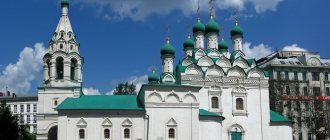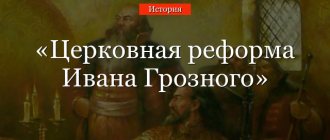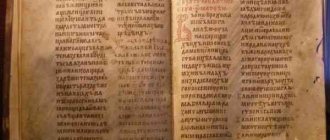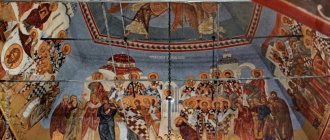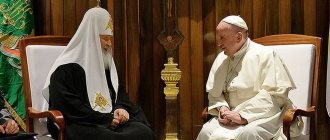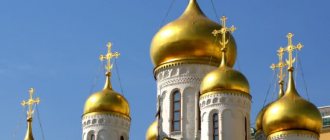Basic provisions of the charter
Of the latest adopted statutes, the Russian Orthodox Church is guided by the document adopted at the Jubilee Council of Bishops in 2000. The edition of the last charter underwent some changes in subsequent years. So, amendments were made in 2008, 2011, 2013, 2021, 2021.
Church charter - rules that govern the activities of the church
The provisions of the charter regulate various aspects of the Church’s activities:
- As an Autocephalous Local Church, the Orthodox Russian Church maintains contact with other Local Churches of the same denomination and is in doctrinal unity with them.
- The charter also defines the procedure for convening the Bishops' and Local Councils, their powers and responsibilities.
- The activities of the Patriarch are the subject of discussion in a separate chapter of the charter.
- In addition, the document includes information about the activities of the Holy Synod, synodal institutions and the Moscow Patriarchate, and regulates the work of the church court.
- This resolution approves the procedure for the formation and subsequent activities of new self-governing churches under the jurisdiction of the Moscow Patriarchate.
- The charter lists all currently existing churches.
- The issues of the activities of the Exarchates and Metropolitan Districts subordinate to the Moscow Patriarchate are examined in detail.
- Within the framework of the charter, provisions are established that define the rules for conducting activities by dioceses, deaneries, and organizations of the Russian Orthodox Church abroad.
- The Charter plays a regulatory role in matters of the creation and functioning of monasteries, educational institutions of the church and other issues relating to all aspects of the life of such organizations.
Important!
In 2013, on the basis of proposals made by the Inter-Council Presence, the Consecrated Council of Bishops adopted a new edition of the Charter of the Russian Orthodox Church. Changes were made regarding the existing powers of the Local and Bishops' Councils, the rules for electing the Patriarch and the composition of the Local Council. Read about the activities of the Church:
- Why do the Orthodox have so many churches?
- Does the Church pay taxes?
- Why and for what does the Church collect money?
Sources of formation of funds and other property of the organization
5.1 The funds of the Church are formed from: 5.1.1 voluntary donations and mandatory contributions from religious associations belonging to the Church; 5.1.2 voluntary donations from commercial and non-profit organizations, institutions, religious associations and other organizations, incl. foreign; 5.1.3 voluntary donations, gifts and bequests of individuals, incl. foreign citizens; 5.1.4 property transferred into the ownership of the Church by commercial and non-profit organizations, state, municipal bodies, local governments, individuals and other persons; 5.1.5 income from the publishing and business activities of the Church; 5.1.6 targeted financing by state, municipal bodies, local governments and other organizations; 5.1.7 other sources not prohibited by current legislation. 5.2 The funds of the Church are spent on the implementation of statutory goals, remuneration of employees, payment of taxes and other payments to the budget and extra-budgetary funds, reimbursement of material costs associated with the implementation of statutory activities, the acquisition of necessary property, charitable and other purposes that do not contradict this Charter. 5.3 Donors, donors and testators retain the right to target contributions. 5.4 The Church may own buildings, land plots, structures, religious objects, objects of production, social, charitable, cultural, educational and other purposes, organizations, funds (including foreign currency) and other property necessary for carrying out statutory activities, incl. classified as historical and cultural monuments. 5.5 In cases and in the manner established by current legislation, the Church may receive, acquire ownership or ownership of land plots. 5.6 The Church may have property on the territory of foreign states. 5.7 To carry out its statutory activities, the Church may use land, buildings and other movable and immovable property provided to it on a contractual basis by state, municipal bodies, local governments, commercial and non-profit organizations, as well as individuals. 5.8 The income of the Church is spent only on achieving the goals defined by this Charter.
History of adoption of the charter
During the period of direct subordination to the Patriarchate of Constantinople, before the acquisition of autocephaly, the Russian Orthodox Church was guided in its activities by the letters of the Ecumenical Patriarchs and the messages of princes and metropolitans. However, the Russian Church also had its own law-making bodies, namely, Councils. Due to the fact that the territory of Rus' was geographically far from Constantinople, most of the statutory documents of the Russian Orthodox Church of that time were issued by the princely authorities.
During the years of enslavement by the Golden Horde, the life of the church was regulated by the decrees of the khan. It is interesting that the powers of the clergy only expanded - the clergy were freed from taxes and were entrusted with conducting legal cases against the laity.
From the time when the Russian Orthodox Church acquired autocephaly, its legal guidelines remained the decisions of the Ecumenical Councils, princely charters, the Nomocanon, and the statutes of Vladimir and Yaroslav the Wise. The Local Council acted as the legislative body.
Important! The Council, convened in 1551 under Tsar Ivan the Terrible, was of historical significance. As a result of the meeting of the clergy, “Stoglav” was adopted, which brought into the system all the existing norms of church law.
In 1667, the Great Local Council took place. At this time, Tsar Alexei Mikhailovich ruled. As part of this meeting, many of the decisions of the previous council were canceled. The famous Nikonov schism occurred. The relationship between state and church authorities was interpreted as follows: the tsar is in charge of state affairs, and the patriarch is in charge of church affairs. The adopted resolutions were included in the collection of laws of the Russian Empire as current laws as part of the “Spiritual Regulations”. The appearance of this document marked the beginning of the Synodal period.
The Council established provisions on differences in church ranks
Not only cathedral decrees have survived to this day, but also letters from bishops, messages and teachings from archpastors. Partially these documents were included in the “Complete Collection of Laws of the Russian Empire” in 1830 and did not lose their force until the 19th century.
At the beginning of the 18th century, the patriarchal system of the Russian Orthodox Church was replaced by a new, synodal one. Emperor Peter I forbade the election of a new patriarch after the death of Adrian. Instead, they established a Spiritual College with the emperor at its head, and later it was renamed the Holy Synod. The basis of the synodal church system of that era was the “Spiritual Regulations”, adopted and approved by the tsar in 1720. This legal document substantiated the advantages of the new form of church government and described the range of tasks that the Synod should solve.
Subsequently, the inconsistency and non-canonical nature of the collegial structure became obvious. The masses publicly discussed this issue and hoped for the convening of a new Local Council that would return the patriarchate. But by the will of the king, this process was delayed and postponed. As a result, the Council took place only after the monarch’s abdication, on the eve of the most difficult times for Orthodoxy.
In 1917-18, new decrees were adopted that returned the previous form of government headed by the Patriarch of All Rus'. Subsequently, the decisions of two more Councils changed the Charter, expanding and narrowing the powers of individual governing bodies of church authority. In 1988, there was a need for a new revision of the existing regulations. The local council, held on the thousandth anniversary of the baptism of Rus', adopted the Charter of the Russian Orthodox Church, detailing the order of government in dioceses and parishes, regulating all aspects of church life. This document became the basis for the next 12 years.
The typicon consists of two sections
The typicon is divided into 2 sections of 60 chapters. The first section is divided into 3 parts:
- Chapters 1-46. This part contains general instructions about divine services and sacred rites.
- Chapters 47-51. It contains instructions about the signs of the holidays and the order of performing divine services for the Menaea of the month. The 48th chapter - Monthly - is the largest in the entire Typikon.
- Chapters from 52 to the end. It contains additions to the remaining chapters, as well as some changing prayers and chants and information about their use in services.
The second section is divided into:
- Temple Chapters, 1-58. Here is how to perform worship on temple holidays.
- Choruses for 9 Songs of the Holy Scriptures – chapter 59.
- Easter and Lunar - table with phases of the Moon - chapter 60.
Church charter of Prince Vladimir
The drafting of the charter, the author of which was Prince Vladimir, dates back to the 10th - early 12th centuries. This resolution introduced a fundamental distinction in the jurisdiction of cases that were to be dealt with by secular and ecclesiastical courts. In addition, the charter established the obligation to pay a tenth of the princely income to the church.
Holy Equal-to-the-Apostles Prince Vladimir
Modern researchers doubted the authenticity of the authorship of Prince Vladimir Svyatoslavich and suggested that the charter could not have been written by him due to chronological discrepancies. However, later the scientist S.V. Yushkov expressed an opinion that became generally accepted in the scientific world. According to him, the written statement of the provisions of the charter could belong to another hand. But Prince Vladimir formulated them.
This feature is characteristic of many ancient monuments, when thoughts expressed by legislative authority were documented in writing after some time.
Important! After Kievan Rus was baptized, the charter of Prince Vladimir became the first normative act that clearly established the boundaries of the power and authority of the Russian Orthodox Church. It also contained provisions according to which the church received monthly maintenance from the princely treasury.
The full rules of worship were recorded in writing in the 11th century. Nikon Montenegrin
By the 11th century. there were 2 branches of statutes: Studite, based on the statute of Theodore the Studite, and Jerusalem, based on the statute of Savva the Sanctified. Nikon Chernogorets took charge of editing and drawing up a unified charter. He found out that there are different editions of the same typikons, with various disagreements among themselves. At the same time, the existing disagreements did not have any serious significance.
Order of 12 Psalms
an echo of the ancient monastery charters
There were two significant differences: all-night vigils on Sundays and holidays and the singing of the Great Doxology at Matins.
In fact, almost everything was ready in order to bring together everything available in the Christian church. After researching all the typikons available to Nikon Montenegrin, he took the Jerusalem one as a basis. There were several reasons:
- The Jerusalem Rule contained references to Holy Scripture. This gave the statute more authority. There are no such references in the Studio Charter.
- The lists with the text of the Jerusalem Rule were older than the lists with the text of the Studite Rule.
- The Jerusalem Rule is stricter than the Studite Rule.
From the 12th century The Jerusalem Charter begins to gradually supplant the Studite Charter. In the 12th century The Jerusalem Charter was adopted in Greece and Georgia in the 14th century. - in Serbia and Bulgaria, in the 15th century. - in Rus'.
Comment on the rating
Thank you, your rating has been taken into account. You can also leave a comment on your rating.
Is the sample document useful?
If the document “Sample.
Model Charter of a Religious Association" was useful for you, we ask you to leave a review about it. Remember just 2 words:
Contract-Lawyer
And add Contract-Yurist.Ru to your bookmarks (Ctrl+D).
You will still need it!
